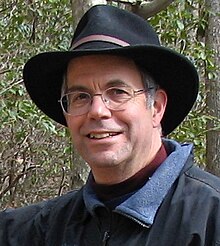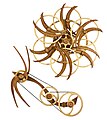David C. Roy
David C. Roy | |
|---|---|
 David C. Roy, Kinetic Sculptor in 2006 | |
| Born | 1952 |
| Education | Boston University |
| Known for | Spring-driven kinetic sculptures of wood |
| Notable work | Dimensions - capable of running 40 hours on a single wind[1] |
| Movement | Kinetic art |
| Spouse(s) | Marjorie E. "Marji" Roy, 1974-present[2] |
| Relatives | Karen Rubin (daughter)[3] |
| Website | woodthatworks |
David C. Roy is a kinetic sculptor.[4][5] He has designed over 150 different moving sculptures and produced one-of-a-kind or limited edition instances of each: In total he has hand-built thousands of pieces.[6][7]
Education and career
[edit]Roy's father was an aeronautical engineer working on jet engines, and as a boy he was interested in invention and science. In 1974, Roy received a degree in physics from Boston University and then got a job as a computer programmer for an insurance company until becoming a sculptor in 1975.[8][9][10] The idea for the career direction came from his wife-to-be, Marji, who was at the time an art student at Rhode Island School of Design.[9]
His sculptures, which are mainly made from laminated Baltic birch hardwood, are not timepieces but they do include clockwork-like mechanisms such as escapements, suspended weights, counter-weights, and (more recently) constant force springs.[1][11][12] They are not electrically powered because an important connection is that the viewer winds the piece by hand.[13] The run time of early models was about 30 minutes, but he has refined the technique to the point that some run up to 40 hours on a single full wind.[14] Many include the moving moiré pattern from co-axial spoked wheels rotating in opposite directions.[15] Roy focuses not only on the motion but also the sound. He has developed escapements that are either nearly silent or that produce the soft clicking of wood on wood.[16] A few incorporate wind chime tubes.[6] In the beginning he hand drew his schematics, but he has gradually migrated to computer-assisted design and animation.[17][18]
His studio is in Ashford, Connecticut.[2]
Reception
[edit]His work has been displayed since the late 1970s in science and art museums, in art galleries, and is in corporate and private collections around the world.[19] His work and life has been covered in publications including The New York Times,[20][21] Discover magazine,[22] the Hartford Courant,[23] and the Boston Globe.[24] Writing for the Baltimore Evening Sun, Carl Schoettler waxed poetically that "Echo ... looks like a spinning wheel for ghost tales at midnight. Serendipity ... might measure rainbows."[25] Bill Aller of the New York Times found them "intriguing."[21] A turning point in Roy's career was acceptance to exhibit at the Northeast Craft Fair in Rhinebeck, New York.[13] Reviewing this exhibit at the 1979 show, Nancy Pappas of the Hartford Courant was impressed with the sculptures' "silent, hypnotic motion."[26] In the Journal Inquirer Richard Tamling wrote about the "...constantly shifting relationships among shapes - as occurs in mobiles - as well as motion and sound[27] In InformArt Magazine, Tyler Chartier found the moving parts create "...wondrous patterns that spin, swirl, flutter, and undulate in the most entrancing ways."[28] Writing for American Woodturner Journal, Peter Rand observed that the motion in the pieces is "...intriguing in its sequence, which is infused with rhythm and evolves over time."[29]
In 2020, Roy was interviewed about his art by Wired.[30]
Gallery
[edit]-
Inventor Released was the third kinetic sculpture from the beginning of his career in 1976. It was weight driven and reflects his goal to make sustained motion in a sculpture.
-
Dimensions is a spring-driven kinetic sculpture designed in 2015. A three-dimensional torus appears in the patterning wheels when the correct directions and speeds are reached.
-
Nautilus is a spring-driven kinetic sculpture designed in 2014. It features visually interesting complex and varied motion from a simple mechanism.
-
Solo is a spring-driven kinetic sculpture designed in 2014. The motion of flight has been a recurring theme in his work first appearing in 1988 in a sculpture called Flight.
-
Variation II Sun is a spring-driven kinetic sculpture designed in 2014. Roy has been inspired by kaleidoscopic patterning throughout his career.
References
[edit]- ^ a b Ouellette, Jennifer (2015-09-14). "These Cool Kinetic Sculptures Can Run 40 Hours After a Single Wind of the Spring". Gizmodo. Retrieved 2016-01-05.
Each machine relies on a constant force spring ... earliest sculptures employed a suspended weight to induce the motion, much like a pendulum clock.
- ^ a b Crockett, Zachary (2015-05-13). "The Kinetic Wood Sculptor". Priceonomics. Retrieved 2016-01-05.
Today, from a small Ashford, Connecticut wood shop,
- ^ Ben Mirin (2013-04-29). "VF Profiles: Karen Rubin - A Passion to Build in Boston". VentureFizz. Retrieved 2015-04-08.
Her father studied physics in college and has since become a professional artist specializing in kinetic motion devices. Her mother studied sculpture and runs the family business that sells her husband's art.
- ^ Beschizza, Rob (2006-11-06). "The Kinetic Wood Sculptures of David Roy". WIRED. Retrieved 2016-01-05.
Since 1975 David has created dozens of these curious works of art
- ^ "Now That's Craftsmanship, Boyo". WIRED. 2004-04-22. Retrieved 2016-01-05.
- ^ a b Roy, David (2011-09-16). "TEDxBGSU - DAVID ROY- KINETIC SCULPTOR". TEDx Talks YouTube Channel, TEDxBGSU, Bowling Green State University, Bowling Green, Ohio. Retrieved 2016-01-05.
...he has designed and handcrafted over 150 different limited edition and one-of-a-kind kinetic sculptures and built thousands
- ^ Roy, David C. "Portfolio". Retrieved 2016-01-09.
- ^ Abrams, Michael (November 2015). "The Beauty of Movement". American Society of Mechanical Engineers. Retrieved 2016-01-05.
...engineering scholarship to Boston University. He switched to chemistry for a while and eventually received a degree in physics.
- ^ a b "Once a physicist: David Roy". Physics World (Institute of Physics, UK). February 2010. Retrieved 2016-01-05.
Towards the end of my degree, I started spending time at the Rhode Island School of Design, where my future (and present!) wife Marji was studying sculpture and art education.
- ^ Kim, Damon; Carlson, Patricia (December 1977). "Small Business and Crafts: Wooden Kinetics". Yankee Magazine. 41 (12): 131.
By the summer of 1975 ... David quit his job in insurance and began working full time on...
- ^ Worrell, Pat (Summer 2002). "All the Right Moves". AmericanStyle Magazine. 8 (4): 80.
The "arms" at the top of David C. Roy's Geppetto ... are counter-weighted by long "legs" that frame the left side of this movable piece.
- ^ Mok, Kimberley (2015-09-18). "These mesmerizing kinetic sculptures run up to 40 hours without electricity". TreeHugger. Retrieved 2016-01-05.
I started using the springs and never looked back.
- ^ a b Schiro, Anne-Marie (1980-06-28). "America's Craftsmen Gather at Rhinebeck". The New York Times. p. C1.
The idea is for you to put in your energy, then sculpture runs for half an hour to an hour
- ^ Jobson, Christopher (2015-09-14). "These self-propelled kinetic wood sculptures by David C. Roy can spin for nearly a day". Colossal. Retrieved 2016-01-05.
mechanical wind-up mechanisms without the aid of electricity ... capable of whirling around for a whopping 40+ hours.
- ^ Roy, David C. (December 2010). "Principles of Design, Kinetic Art" (PDF). Northwest Woodturners Newsletter. 17 (12).
...wheels so they always move at the same pace but in opposite directions...
- ^ Ehrlich, Lara (Spring 2016). "Art in Motion". Boston University, College of Arts and Sciences magazine. Retrieved 2017-03-26. includes a video How to Make a Kinetic Sculpture
- ^ MacWorld, Macintosh Master Calendar. April 1991.
Roy designs all his kinetic sculptures using Illustrator 88. He uses Swivel 3D and MacroMind Director to produce animated prototypes.
- ^ Bedford, Mike (September 2001). Computer Shopper UK: Sculpture Club. p. 320.
...using Adobe Illustrator on an Apple Mac is just the start.
- ^ "'Energy Sculpture' at Bruce Museum – a visual motion study". The Greenwich Times. 1983-03-12.
- ^ Malarcher, Patricia (1986-12-07). "CRAFTS; A Guide To Holiday Shopping". The New York Times. Retrieved 2016-01-05.
Also featured here are mesmerising kinetic sculptures by David Roy...
- ^ a b Aller, Bill (1979-05-24). "Handmade Crafts by Theater Artists". The New York Times.
Some of the more intriguing pieces are kinetic wall sculpture by Dave and Margie Roy
- ^ Kim, Scott (2003-10-01). "Bogglers: Spinning". Discover Magazine. 24 (10): 83. Retrieved 2016-01-05.
David Roy is an artist in Ashford, Connecticut, who has always been fascinated by motion and mechanics.
- ^ Croft, Jack (1987-02-20). "Couple toy with kinetics, succeed in business". The Hartford Courant, Eastern Edition. p. D3.
- ^ Temin, Christine (1982-05-27). "Critic's Tip: Exhibits: Sculpture that does things". The Boston Globe.
- ^ Schoettler, Carl (1978-02-17). "Some Ado About Machines Working Well Doing Nothing". The Evening Sun, Baltimore.
Echo ... looks like a spinning wheel for ghost tales at midnight. Serendipity ... might measure rainbows.
- ^ Pappas, Nancy (1979-06-22). "Rhinebeck: A Crafts Mecca". The Hartford Courant.
...wind-up weights attached to almost-invisible strings can keep the sculptures in silent, hypnotic motion for as much as three hours at a stretch.
- ^ Tamling, Richard (1984-06-25). "Sculpture that Performs deserving of Applause". Journal Inquirer. p. 23.
...figures that travel - that spin, somersault and rotate - and form shifting constellations of shapes ... constantly shifting relationships among shapes - as occurs in mobiles - as well as motion and sound.
- ^ Chartier, Tyler W. (Fall 2004). "David Roy – Sculpture in Motion". InformArt Magazine. 15 (4): 46.
[The real art] is a visual interplay between the different physical pieces that creates wondrous patterns that spin, swirl, flutter, and undulate in the most entrancing ways.
- ^ Rand, Peter (February 2012). "Turning to the Next Dimension. Real Movement in Turned Objects". American Woodturner Journal. 41 (12): 38–45.
Motion in these geometric pieces is complex, of variable speed and pattern formation, and intriguing in its sequence, which is infused with rhythm and evolves over time.
- ^ "How This Guy Builds Mesmerizing Kinetic Sculptures". Wired. 2020-02-20. Retrieved 2021-04-18.





